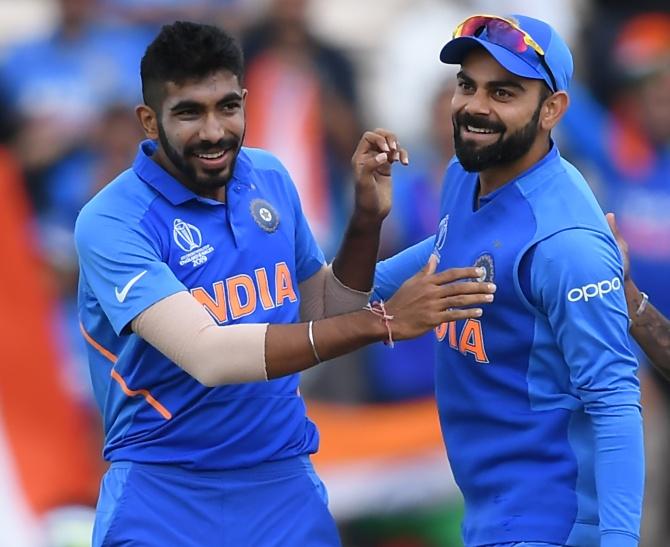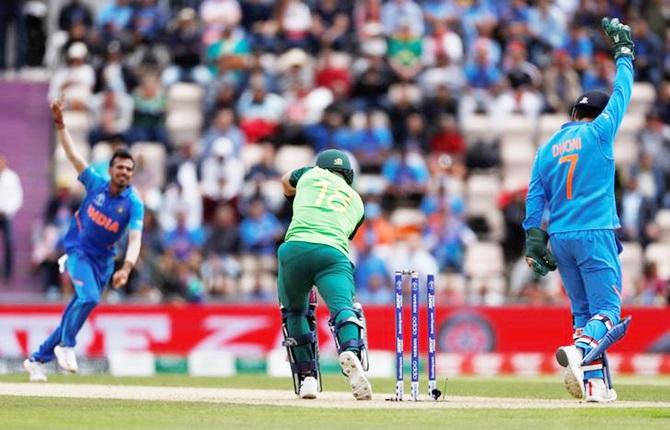Consistent death bowling from a Bumrah and spinners picking up wickets in the middle overs is why the average run-rate in the last few years hasn't exploded the way one would have expected, says Dhruv Munjal.

It's been like one of those phenomenal fashion makeovers stylists pull off on TV.
Some unremarkable, stodgily dressed bloke walks in at the beginning of the show and walks off a completely different man, barely able to believe the transformation he has undergone.
That's England cricket for you these days: Once boring and conservative, now modern, glamorous and fabulously watchable.
What's more, they even have a World Cup kit that should keep pace with their on-field charisma: A powder blue jersey, with a touch of dark blue around the collar.
It's a throwback to 1992, the last time they made the tournament's final.
It's a little ironic that England wants to go back 27 years, and to a game that was won not by a muscular display of batting, but by a young Wasim Akram bowling really fast -- and smart.
That, of course, was a time when the contest between bat and ball was more even, pitches more challenging and crowds significantly safer.

Partly due to its own timidity from eras past, modern England has ensured that memories from the halcyon days of the 1990s are shredded and, well, thrown out of the boundary.
So absolute has been England's batting dominance in recent years that they've almost rendered the limited-overs bowler meaningless.
Their own bowlers have got caught up in this maelstrom of fours and sixes, too, but they've repeatedly dismissed the claim of disfiguring an already skewed bat-ball equation with a ruthlessness that has also become the hallmark of their batting.
In the recent 4-0 shellacking of Pakistan, England twice chased down targets in excess of 340 with utmost ease.
The other two times, they put up scores of more than 350. In 88 games since the last World Cup, England have stormed the 300-barrier a ridiculous 38 times.
India is next best with 22. Of the 38, 16 have been over 350; all the other teams have managed that 37 times combined.
Their average run-rate during the same period, a once-unthinkable 6.29, is unrivalled.
In fact, when it comes to putting up 300s on the board, the only thing that can even remotely challenge England right now is Narendra Damodardas Modi.
Their obsession has taken such a dangerous turn that pacer Mark Wood feels that the side could get 500 in a one-day international game some day, an opinion backed by Indian Skipper Virat Kohli, albeit cheekily.
The hype is such that the official World Cup scoring sheet had to be reprinted to accommodate an additional column, just in case a side were to reach 500.
Which is perhaps a good time to ask: Is the limited-overs bowler even relevant anymore?
We've obviously been here before, but ahead of a World Cup that will see flat dry pitches, ultra-aggressive batting mindsets and a host nation determined to rewrite the ODI scoring records, it may be prudent to stop and ask what the role of the modern limited-overs bowler is.
What does he do exactly? Where does he go from here?

In the aftermath of the England-Pakistan series, cricket commentator Harsha Bhogle spoke about how he feared that the World Cup might turn into nothing but a 'my-bat-better-than-your-bat' event.
That's a fair and urgent concern, for the beauty of the ODI always lay in the variables it threw up, drastically different periods in a game that each demand a different set of skill, technique and temperament.
The modern ODI now merely mirrors a T20 game, something akin to an extended highlights package where almost every shot looks the same.
The tempo almost always remains the same throughout, making viewing tedious and the need for interesting old-school ODI games -- the 230-250 kind -- more pressing.
'You're going to have a pretty thick skin to do well in international cricket, particularly on the flatter wickets and the fast outfields and the big squares we play on in England,' stated Australian coach Justin Langer. 'In T20, it's (bowling) absolutely critical and the same in ODI cricket.'
It's a strange time for bowlers: On one level, the lopsided nature of the game has ensured they might as well be replaced with bowling machines; on another, with the margins so slim, their importance is perhaps greater than ever.
"A spectator wants to see close matches. Limited-overs cricket needs to be careful that it does not swing the balance of the game too much in the favour of batsmen," says John Buchanan, who coached Australia to World Cup wins in 2003 and 2007.
That balance may already have been distorted, but the International Cricket Council in recent years has made regular and wholesale changes to the rules to arrest that slide and make ODIs more bowler-friendly.
After the last World Cup, it did away with the batting powerplay and relaxed the field restrictions, allowing an additional fielder outside the circle in the last 10 overs.
All of that, however, has been offset by the changing mindsets of batsmen, who, backed by greater belief and power, are convinced that no score is unattainable.
'T20 leagues around the world have changed the way batsmen think, and that has made the difference,' said Sachin Tendulkar recently.
Matters have been compounded by the use of two new balls, one from each end.
The ICC ratified the move in 2012, hoping that the tweak would allow for more swing.
Instead, with changes in weather conditions in places like England, once a favourite stamping ground of bowlers, swing has almost disappeared from the ODI scene.
The loss of reverse swing -- a tactic that skilled pacers once employed with tremendous success -- has been collateral damage.
Part of the problem lies in the white Kookaburra ball that is used in international limited overs cricket.
Critics argue that the machine-stitched ball neither lasts the full 50 overs nor offers any movement.
A possible alternative is the white Duke ball, last used in the 1999 World Cup.
Player accounts -- Akram always preferred it -- suggest that its hand-stitched seam helps it retain shape and also provide the kind of prodigious swing that bowlers relish.
Duke's British-Indian owner, Dilip Jajodia, in fact, has long been lobbying for a change in the official ball, desperately hoping to revive spectator interest in ODI cricket in the process.
Such adversity has also spawned innovation, though, compelling bowlers to come up with new variations.

Some, like India's pace sensation, Jasprit Bumrah, have built superb reputations solely on their ability to contain batsmen, death-over specialists that often prove to be match-winners.
In only three years, Bumrah, 25, has established himself as the world's premier fast bowler, relying on pace, accuracy, change-ups and a lethal yorker.
A part of Bumrah's brilliance is down to his action -- his run-up comprises only a few paces, but he bowls a heavy ball, delivering it in a strange, biomechanics-defying fashion.
It is a weirdly beautiful motion that is awkward to face, and impossible to replicate.
In some ways, being 'weird' is among the few ways bowlers can survive.
Much like Lasith Malinga before him, Bumrah is one of those rare specimens that are a departure from the conventional, making him one of the very few bowlers that oppositions dread.
"I'd say Bumrah is my top choice for the World Cup. He has a terrific record, and he absolutely nails his yorkers. What an asset," says former Australian quick Brett Lee.
Teams that do not possess the verve of Bumrah have turned to wrist spin to counter the threat of rampaging batsmen.
At the 2015 edition, the only wrist spinners in action of note were South Africa's Imran Tahir and Pakistan's Yasir Shah.
Now, almost every team has one. Captains like them for valid reasons: They spin it both ways, make run-scoring difficult, extract more from unhelpful pitches, and pose a far greater wicket-taking threat than your traditional finger spinner.
They can be erratic and expensive, but that's a risk teams now seem willing to take.
Also lurking is the ambidextrous spinner, who is likely to take the wrist spinner's place once more batsmen start figuring the latter out.
"It essentially is a game of containment. But bowlers who can get wickets will do well. It may be a cliche, but that is the only way you can stop the batsmen," says former India coach Anshuman Gaekwad.
Consistent death bowling from a Bumrah and spinners picking up wickets in the middle overs is partially why the average run-rate in the last few years hasn't exploded the way one would have expected.
The average run-rate has crept up from 4.68 in 2000 to 5.49 in 2019.
In 2015, that number was 5.5, the highest it's ever been.
The slight stagnation of run rate is little consolation. Power hitting has ensured that certain species of cricketers -- both batsmen and bowlers -- have, in some ways, become obsolete.

No team, for instance, wants to pick an off-spinner turning the ball into the right-hander.
So much so that Ravichandran Ashwin, who enjoyed a stellar Indian Premier League season, wasn't even a part of the discussion for India's World Cup squad.
More pronounced has been the death of the proverbial dibbly-dobblies, slow medium-pace bowlers who, with their 'wicket-to-wicket' lines, were trusted with a few overs whenever a new batsman came in, or were called upon to break a partnership.
Equally sudden has been the demise of the 'cultured' ODI batsman, one who could leave balls, hit the odd boundary and consistently go at a strike rate of 75, a la Jacques Kallis or Jonathan Trott.
Things have changed so much that England's Joe Root, your archetypal 'nudger', boasts of a strike rate of almost 88.
In fact, probably barring Root, England's batting consists of one-dimensional batsmen who can belt the ball on demand -- it's not their fault, that is what the modern game makes you do.
Moreover, such an approach has altered the basics of bowling itself.
Sanjay Manjrekar, in a column for ESPNcricinfo a few years ago, mentioned how the good-length ball, a delivery where the batsman doesn't know whether to play front or back, is going out of fashion.
'A few years ago you avoided bowling good-length deliveries only in the death overs, but in the series between Australia and India (2016), seamers were bowling everywhere but in the good-length area right through the 50 overs,' he wrote.
Manjrekar's argument explains why bowlers now end up trying too much without perfecting one skill -- Bumrah's yorker, for example -- and flounder in the face of batsmen going berserk.
With a long tournament, they may be in for some respite if the pitches deteriorate deep into the competition.
But otherwise, the World Cup looks set to showcase only one of its two main disciplines. As they often say: 'Who'd want to be a bowler?'











